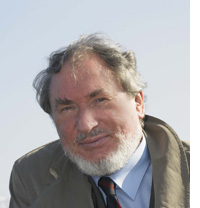HK Gruber: interview looking into the open…

HK Gruber introduces his new work for percussion and orchestra, performed at the BBC Proms and Wien Modern by Colin Currie. into the open... is both a processional through a percussive landscape and a tribute to publisher David Drew.
What draws you to percussion in general?
Percussion is a fundamental element in music relating to rhythm. You can trace it to the heartbeat itself, but in the modern musical world it probably grew out of military drumming. If you listen to a top fife and drum marching band who cares about the bagpipes? It is the extraordinary variations and permutations of the drummers that grab my ears. I look for the same fantasy in the percussion writing in notated concert works. If it is supporting the rhythmic activity of the rest of the orchestra it has to be done intelligently, and this is a problem I have with a lot of pop or light music where it merely doubles what can already be heard without the percussion. At its best, perhaps in a Mahler symphony, every triangle stroke or cymbal clash has a purpose and is an essential part of the journey.
How does into the open… stand in relation to your first concerto Rough Music?
Rough Music was largely concerned with percussive noise-making in all its extrovert forms and was very much a traditional solo vehicle. into the open… is very different because it is a symphonic piece without a display of wild drumming, concentrating instead on percussion with distinct pitches, either tuned or reinforced by orchestral instruments. The percussion part is shadowed in the orchestra, sometimes anticipated, sometimes prolonged with a pedal note. Together they form unexpected sonorities with bell-like attacks.
What are Colin Currie’s special qualities as a soloist?
I’ve worked with Colin a lot, including many performances of Rough Music, and for me he is exceptional as a percussionist for combining two qualities. He is a precision time-piece, whose body is a metronome functioning like a digital computer. Yet in slower, lyrical music he is more like a violinist, cellist or even a singer, drawing out sustained melody from the percussion instruments.
How did ideas for into the open… come about?
It had a curious and slightly uncanny genesis. Composing the opening I opted for a slow, meditative processional, as if the soloist is walking through a ‘pitch landscape’. Then partway into the single movement span, I heard of the death of David Drew and this influenced the course of the rest of the piece, but the first section now seems to be a premonition of what the work would become. A broken melody emerges, building upon the ritual opening and trying to form itself into a half-remembered lament, with successive interruptions.
David was – and still remains – a powerful mentor to me as well as a much-loved friend. He signed me to be published by Boosey & Hawkes which was the day that changed my life. I view the piece as a tribute not a memorial, because David is still very much looking over my shoulder, prompting, suggesting, encouraging, and in the final pages I wanted to capture the sense of his spirit going out into open space.
What percussion colours did you select?
I started with particular sonorities in mind, with each pitch linked to an instrument so that there is a ‘register fix’ from low to high. Then, with the score complete, Colin Currie has worked at refining and rationalising the instrumentation, substituting percussion where necessary for practical reasons while retaining the overall colour and function. I’m grateful for Colin’s specialist expertise, as this means that the piece is performable in terms of the percussion layout on stage, could be more readily transportable, and further down the road should be more attractive for a range of soloists. The finalised collection ranges from conventional orchestral percussion, through mallet keyboards, to more exotic instruments including Chinese temple gongs, Caribbean cencerros and South American cajón.
How do you view the concerto genre in the 21st century?
Much the same as I viewed it in the 20th century. I’m drawn to concertos that are symphonic in conception, for instance the Stravinsky Violin Concerto, or the concertos of Prokofieff, or even pieces like Britten’s Our Hunting Fathers or Serenade which I view as concertos for the voice. I always really wanted to write symphonic works, but it was a welcome quirk of fate that I was approached by fellow musicians, such as Ernst Kovacic, Gerald Fromme, Yo-Yo Ma and Håkan Hardenberger, to write concertos. In my early career, when my tonal music was distinctly unfashionable, I would rather write a concerto for a friend who would love a piece, than a symphonic work for critics or audience who didn’t want to hear it. If you have an engaged performer there is a special chamber music intimacy that goes beyond virtuosity and this inspires the orchestra in turn – then you have the best conditions for an ideal concerto performance.
Interview by David Allenby
HK Gruber
into the open… (2010) 25’
for percussion and orchestra
20 July 2015 (world premiere)
BBC Proms, Royal Albert Hall, London, 7.30 pm
Colin Currie/BBC Philharmonic/John Storgårds
Pre-performance talk, Royal College of Music, 5.45 pm
15 November 2015 (Austrian premiere)
Wien Modern, Konzerthaus, Vienna
Colin Currie/Wiener Symphoniker/Erik Nielsen
> Further information on Work: into the open ...
Photo: Lucerne Festival
